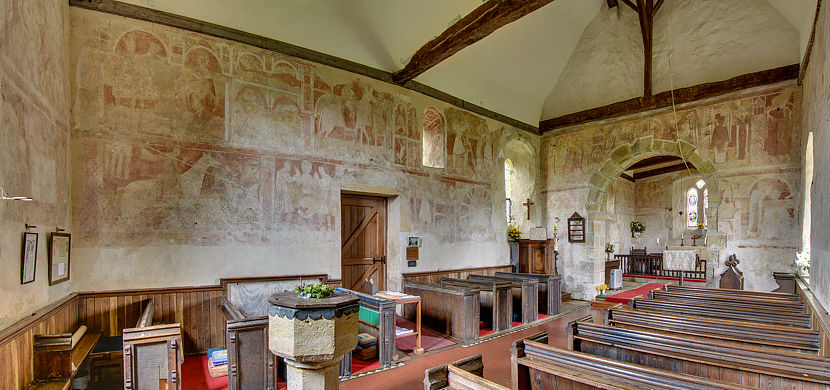Medieval Wall Painting
A Short Introduction
Probably as soon as internal church walls began to be covered with smooth plaster the habit of painting on them began; even in Saxon times there were a few stone churches and some of these must have had paintings. For all practical purposes though, wall painting in the English church dates from after the Norman Conquest, and a few 11th century paintings still survive.¹ In later centuries there was much stylistic development, and this continued down to the English Reformation, where the story effectively ends in successive waves of iconoclastic destruction. From the start the materials were of the simplest – the universal use of the earth pigments red and yellow ochre reflects the fact that they were widely available. Together with black and white these, variously mixed to provide a surprisingly wide range of shades, form the basic palette. Blues are rare – the stable pigment ultramarine made from lapis lazuli cost more than gold leaf, and even cheaper blues were expensive. Green, usually a copper salt, is sometimes found, and occasionally the brighter but thoroughly unstable red, vermilion.
 The nave at Hardham Church – Photo © Roy Reed 2019
The nave at Hardham Church – Photo © Roy Reed 2019
Some underdrawing seems to have gone on, but after that the paint went straight onto the prepared wall – preparation in this case being limited to a coat of sizing material, usually based on casein or a thin skim of lime plaster. True fresco, where a fresh area of wet plaster is worked on immediately after application, is extremely rare in the English parish church, although there are two examples (Ickleton and Copford) in these pages.
The subjects painted come mainly from Christian history, although some secular scenes appear and there is much decorative painting – scrollwork, flower and leaf patterns, and so on. ‘Christian history’ in the Middle Ages, though, involved a great deal more than the Christian story as narrated in the New Testament. There are examples on these pages of the ‘accretions’ which clustered around the Gospel accounts and were firmly believed in as historical fact, such as the story of Longinus. Although specific parallels between what was preached in the church and the stories that appeared on the walls are hard to track down, the painted wall clearly had much the same didactic intention as the sermon – in other words to teach Christian truth as it was understood, and to improve people’s behaviour through moral instruction and example. Some very specific examples of the latter – the ‘Moralities’ have survived, and there are several on this site. By contrast, in fact, paintings of Christ’s earthly ministry, including the Miracles, are now very rare indeed, and seem always to have been so.
The old idea that early church wall painting in England (or indeed elsewhere) is best described as ‘primitive’, or ‘naive’ needs to be resisted. These descriptions no doubt owe something to the post-Enlightenment aesthetic that saw such paintings as evidence not merely of Popery, but of crude vulgarity as well. Later on, Victorian sensibilities, more kindly but still reductively, added ‘quaint’ to the list of epithets, and this is still found in older books on the subject. What matters here is what was missed as a result – namely an understanding of what the anonymous painters of these walls were trying to do, which was certainly not to daub haphazardly because only the sacred content mattered. One has only to see the evidence, as the 15th century wore on, of painters trying to figure out mathematical perspective by eye, and almost managing it, to realise that although they may have been less talented than the painters of the Continental Renaissance, or the English cathedral painters, or the manuscript painters, they were no less serious in intention.
¹ (The earliest layer of the remarkable paintings now being uncovered at Houghton-on-the-Hill, near Swaffham in Norfolk, may prove to date from the 10th century.)